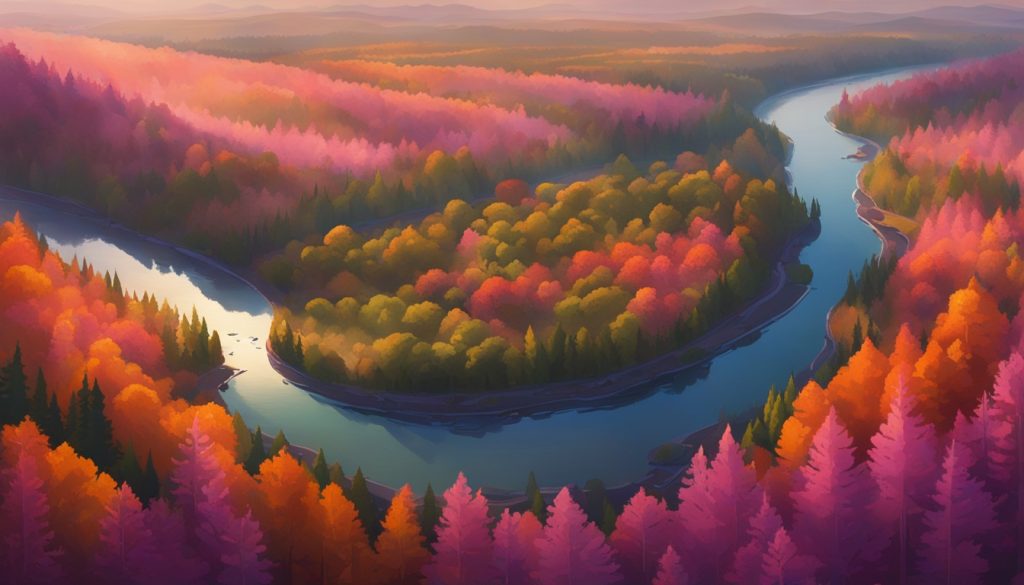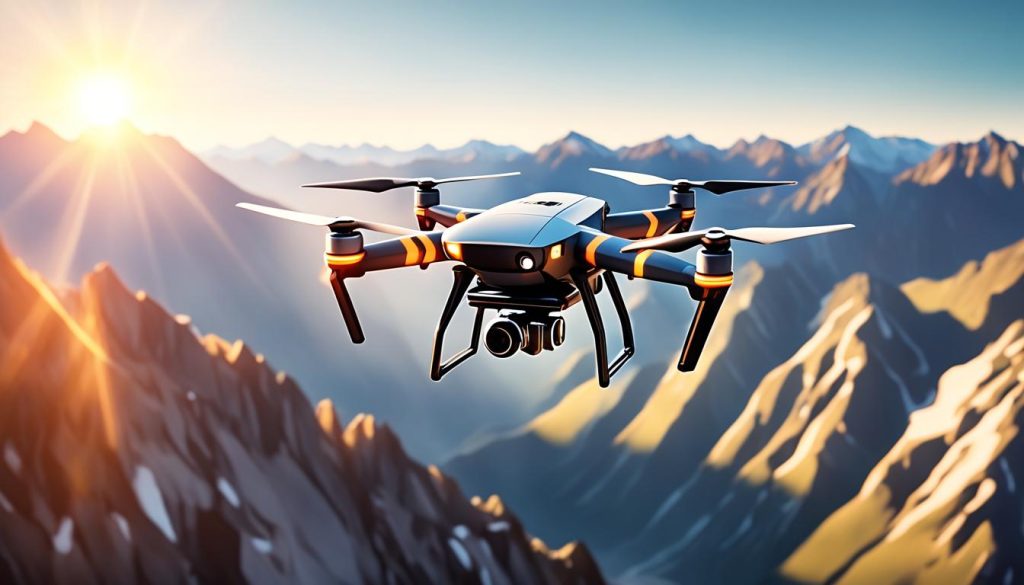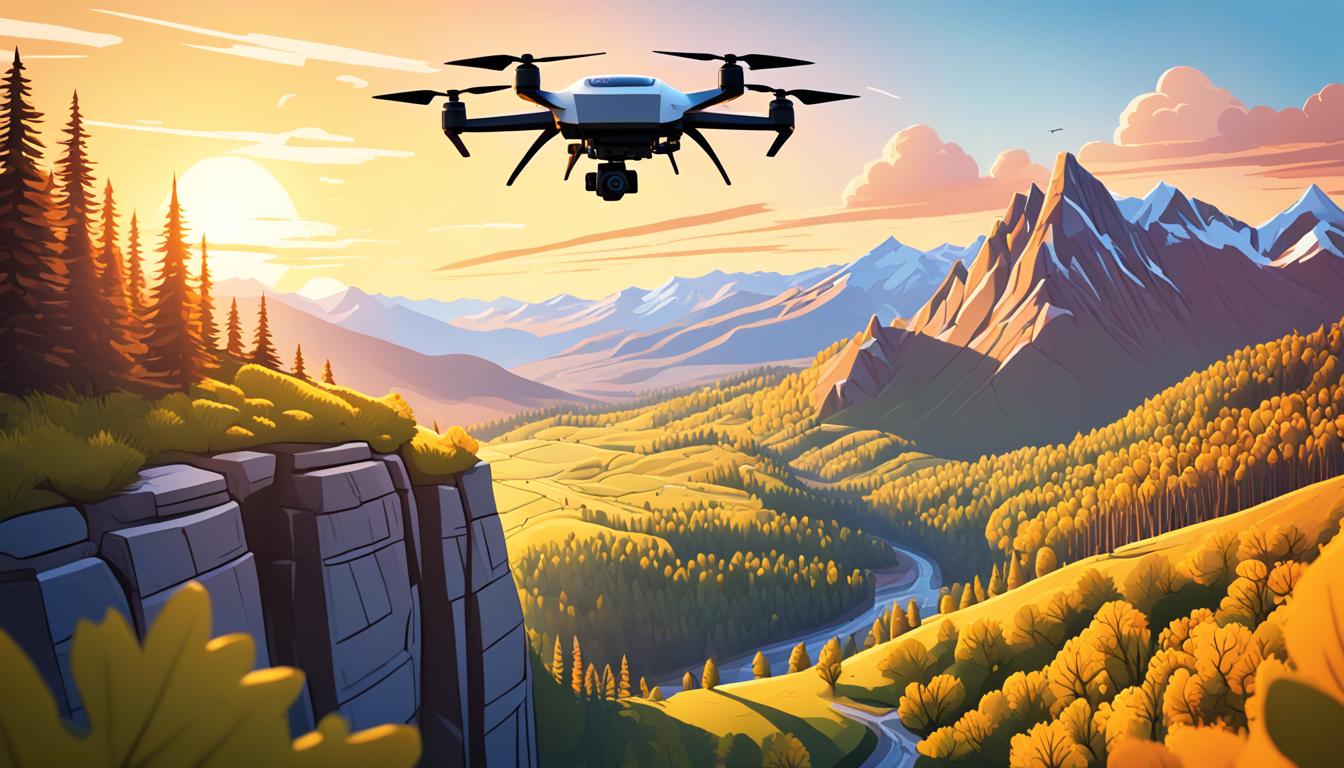To get amazing golden hour hyperlapse drone shots, learn aerial cinematography and use modern drones well. Mix the soft, warm golden hour light with drone movements for eye-catching shots.
Golden hour happens right after sunrise or before sunset. It’s perfect for drone shots. Use drones like the DJI Mavic 3 or Mini 3 Pro with hyperlapse features. These drones let you mix timelapse with drone movement for stunning footage.
To get top-notch results, know how your drone, camera settings, and golden hour light work together. Mastering these will help you make hyperlapse videos that really pop in aerial cinematography.
Understanding Drone Hyperlapse Photography
Drone hyperlapse photography combines aerial shots with time-lapse to make amazing visuals. This new way of capturing motion and time has changed aerial photography. It gives us a unique look at landscapes and cityscapes.
What is a drone hyperlapse?
A drone hyperlapse is when a drone takes photos from the air at regular intervals as it moves. These photos are then put together to make a smooth, fast video. This method lets you show big changes in scenery or light quickly.
How it differs from traditional timelapse
Unlike regular time-lapse videos, drone timelapses move between shots. This movement adds depth and makes the footage more engaging. It lets you capture wide aerial views and control time, making it unique in aerial photography.
Equipment needed for drone hyperlapse
To make great drone hyperlapse photos, you need certain gear:
- A drone with hyperlapse capabilities
- High-capacity SD card
- Neutral Density (ND) filters
- Spare batteries
- A powerful editing software
| Equipment | Purpose | Importance |
|---|---|---|
| Drone with hyperlapse mode | Captures aerial footage | Essential |
| High-capacity SD card | Stores large number of images | Critical |
| ND filters | Controls exposure in bright conditions | Very Important |
| Spare batteries | Extends flight time | Necessary |
| Editing software | Processes and compiles footage | Crucial |
To get good at drone hyperlapse photography, learn about camera settings, flying, and how to compose shots. With practice, you can make stunning aerial videos that show time and motion from above.
The Magic of Golden Hour for Aerial Cinematography
Golden hour photography adds a special touch to aerial shots. It happens right after sunrise or before sunset. This time offers balanced light and beautiful visuals for drone videos.
The sun’s low angle during golden hour creates long shadows and soft, warm light. This light makes landscapes look stunning.
Catching a sunset timelapse during golden hour gives amazing results. The sky changes from warm oranges to cool purples, adding depth to your shots. Plan your shoot well to capture this moment. Adjust your camera settings as the light changes.
Landscape cinematography looks great with golden hour lighting. The warm light highlights textures and shapes, making your footage look real. Pick scenes like rolling hills, coasts, or city skylines that look good in this light.
| Golden Hour Advantage | Impact on Drone Footage |
|---|---|
| Soft, warm light | Enhances colors and textures |
| Long shadows | Adds depth and dimension |
| Balanced exposure | Reduces noise, improves image quality |
| Dynamic sky colors | Creates dramatic backdrops |
Mastering golden hour drone photography can take your aerial work to the next level. With perfect lighting and your creative touch, you’ll make footage that grabs attention.
Choosing the Perfect Location for Your Hyperlapse
Finding the right spot for your drone hyperlapse is key in landscape cinematography. The perfect aerial photography locations can make your footage stand out. Let’s look at how to pick these ideal spots for your drone videography projects.
Scouting Techniques
Begin by researching online. Use Google Earth to check out areas and spot interesting features. Then, visit these places in person to see the lighting and any obstacles. Keep a list of good spots for future shoots.
Ideal Landscape Features
Search for places with changing elements. Busy cities, flowing rivers, or shifting clouds are great. Scenic views and famous landmarks can also make for stunning backdrops. Think about how the scene will look during the golden hour for extra visual appeal.
Considering Legal Restrictions
Always check the drone laws before flying. Know about no-fly zones, height limits, and privacy laws. Some places need permits for commercial drone use. Following these rules ensures safe and legal flying.
| Location Type | Pros | Cons |
|---|---|---|
| Urban Landscapes | Dynamic movement, interesting architecture | More flight restrictions, privacy concerns |
| Natural Scenery | Beautiful vistas, fewer restrictions | Limited movement in scene, weather dependent |
| Coastal Areas | Dramatic light changes, water movement | Wind challenges, corrosion risk for equipment |
By thinking about these factors, you’ll be ready to pick great locations for your drone hyperlapse projects. The right setting can take your landscape cinematography to new levels.
Essential Drone Settings for Hyperlapse Photography
Mastering drone camera settings is key for amazing hyperlapse footage. You need to tweak your aerial photography and hyperlapse settings for pro results. Let’s explore the must-know settings to boost your drone hyperlapse skills.
Begin by setting your drone’s shutter speed to 1/30 second. This slower speed adds a smooth motion blur, making your hyperlapse look cinematic. Combine this with a 4-second interval between shots for a seamless final video.
Keep your ISO as low as you can to reduce noise in your photos. If it’s bright out, use ND filters to keep your shutter speed right without overexposing your shots. This is a top tip for pro-quality aerial photos.
White balance is super important during golden hour shoots. Adjust it by hand to get the warm, golden tones right. Always shoot in RAW format for the most flexibility in editing without losing quality.
| Setting | Recommended Value | Purpose |
|---|---|---|
| Shutter Speed | 1/30 second | Create smooth motion blur |
| Interval | 4 seconds | Ensure smooth transitions |
| ISO | Lowest possible | Minimize image noise |
| Format | RAW | Maximum editing flexibility |
By getting these drone camera settings and hyperlapse techniques right, you’ll be on your way to stunning aerial timelapses. They’ll capture the magic of golden hour perfectly.
Planning Your Flight Path and Composition
Creating stunning drone shots means planning your flight paths and composition well. By getting these right, you’ll take your hyperlapse videos to the next level.
Using Waypoints Effectively
Waypoints give you precise control over your drone’s path. Set several points along your route for smooth movements. This method lets you move up, down, or side to side between points, making your drone shots more exciting.
Creating Dynamic Movements
Try out different flight modes to spice up your aerial shots. Course-Lock keeps your drone flying straight, great for steady lines. Circle mode makes your drone orbit around something. Freeform lets you move freely. Combining these modes helps you make your drone shots stand out.
Balancing Foreground and Background Elements
For amazing hyperlapse videos, balance your composition well. Add foreground elements to frame your shot and show motion. Use the rule of thirds to place subjects off-center for more interest. Leading lines in the landscape can guide viewers’ eyes through the scene. By thinking about these things, you’ll make aerial shots that grab your audience’s attention.
- Frame shots with foreground elements
- Apply the rule of thirds for subject placement
- Utilize leading lines in the landscape
- Balance visual elements for compelling compositions
Capture Stunning Golden Hour Hyperlapse Drone Footage

Golden hour drone footage is a chance to make amazing aerial videos. It’s important to plan your shoot during the first or last hour of daylight. This is when the sun makes the landscape look warm and soft.
Begin by using your drone’s hyperlapse modes. Change the interval and duration to get the look you want. Try for smooth movements that match the light’s changes. This makes your golden hour footage look even better.
Try different angles and heights to show off the landscape’s beauty. Flying low can capture dramatic shadows. Flying high shows wide views in golden light. Remember, the light changes fast during this time, so work quickly.
- Use ND filters to control exposure in bright conditions
- Set your camera to manual mode for consistent exposure
- Choose a slower shutter speed to create motion blur
- Adjust white balance to enhance golden tones
When doing hyperlapse, keep your drone flying smoothly for a good flow between frames. Use waypoints for precise, repeatable shots. This lets you focus on the shot while the drone moves on its own.
With these tips, you’ll be ready to make amazing golden hour hyperlapse drone videos. These videos will show off your location’s beauty in a moving and beautiful way.
Mastering Camera Techniques for Smooth Footage
To get smooth hyperlapse footage with your drone, you need to know some key camera techniques. Adjust your settings and use the right gear to make amazing aerial shots that will impress everyone.
Optimal Shutter Speed and Interval Settings
For smooth footage, set your shutter speed to 1/30 second. This makes the motion look natural and gives it a movie-like quality. Change the intervals to 2-5 seconds, depending on how much your scene is moving.
Use slower intervals for still landscapes and faster ones for busy city scenes.
Using ND Filters for Better Exposure Control
ND filters are a must for hyperlapse shots with drones. They cut down the light that gets into the lens. This lets you keep your shutter speed right, even when it’s bright outside. For most daytime shots, use ND4 or ND8 filters.
Maintaining Focus Throughout the Sequence
To keep your hyperlapse footage sharp and smooth, use autofocus for steady focus. If you like manual focus, set it on something in your scene you want to keep clear. Check how stable your drone is flying and tweak settings to keep the movement smooth between shots.
| Setting | Recommended Value | Purpose |
|---|---|---|
| Shutter Speed | 1/30 second | Create natural motion blur |
| Interval | 2-5 seconds | Control footage speed |
| ND Filter | ND4 or ND8 | Maintain desired exposure |
Mastering these drone camera techniques will help you get amazing smooth hyperlapse footage. Your shots will look incredible and really stand out.
Overcoming Challenges in Golden Hour Drone Photography
Golden hour shooting with drones comes with its own set of challenges. The light changes fast during this magical time, so you need to think and adapt quickly. To get amazing aerial shots, learn special techniques and beat common problems.

Wind can be a big problem during golden hour shoots. Always check your drone’s wind speed and change your flight plan if needed. For flying in low light safely, use a drone with features that avoid obstacles.
Flight time is limited during golden hour. Keep extra batteries on hand and plan your shots well. Plan your aerial shots before you start to use the light and battery efficiently.
Fast-changing light can be tough. Use bracketing to take several shots at different exposures. This way, you’ll have the perfect image. Be ready to change your camera settings fast to keep the exposure right during your shoot.
| Challenge | Solution |
|---|---|
| Changing light conditions | Use bracketing techniques |
| Wind interference | Monitor wind speed indicators |
| Limited flight time | Carry spare batteries |
| Low-light flying | Use obstacle avoidance features |
With these tips for aerial cinematography, you’ll be ready to face the challenges of golden hour drone photography. You’ll capture stunning footage that really stands out.
Post-Processing Your Hyperlapse Footage
After you’ve taken your golden hour drone hyperlapse, it’s time to enhance it. This step turns raw footage into a beautiful visual work of art. Let’s look at the key parts of editing hyperlapses and processing drone footage.
Software Options for Hyperlapse Editing
For editing your hyperlapse, pick strong software. Adobe Premiere Pro is great for pros, and Final Cut Pro is for Mac users. LRTimelapse is all about making timelapses and hyperlapses, offering special tools for smoothing and grading your clips.
Color Grading for Golden Hour Aesthetics
Make the golden hour’s warm tones pop with color grading. Adjust warmth, saturation, and contrast to boost the magical glow. Try using Look-Up Tables (LUTs) made for golden hour footage for a cinematic feel. Adjust highlights and shadows to keep details in bright skies and dark landscapes.
Stabilization Techniques in Post-Production
Fix any remaining shake in your hyperlapse with stabilization tools. Tools like Warp Stabilizer in Adobe Premiere Pro or similar in other software can help a lot. For more control, try manual keyframing to get your footage just right. Just remember to keep the dynamic feel of your hyperlapse movement.
To make your hyperlapse even better, try speed ramping. This changes the playback speed in your sequence, adding drama that grabs viewers. Use these post-processing tricks to take your golden hour drone hyperlapse from great to amazing.
Advanced Hyperlapse Techniques for Cinematic Results
Take your drone videos to the next level with advanced hyperlapse techniques. These methods will make your aerial shots look amazing. Let’s dive into some top-notch ways to make your hyperlapse videos stand out.
Link several hyperlapse shots together to tell a story. Begin with a wide shot, then zoom in to show details. This makes your drone shots more interesting and deep.
Try changing speeds in one hyperlapse. Slow down for important parts, then speed up for excitement. This keeps viewers hooked and makes your aerial videos more powerful.
Add motion graphics to your hyperlapse for extra style. Use text, animations, or data to explain your story better.
| Technique | Effect | Application |
|---|---|---|
| Vertigo Effect | Creates a sense of disorientation | Revealing dramatic landscapes |
| Masking Transitions | Smooth scene changes | Connecting different locations |
| Gimbal Control | Precise camera movements | Smooth pans and tilts |
Learn the vertigo effect to make your videos feel real. This trick zooms in while moving the drone back, or vice versa. It gives a cool, immersive look that grabs viewers.
Use masking for smooth scene changes. This cool technique lets you blend hyperlapse shots together. It makes your aerial videos look smooth and beautiful.
Safety Considerations and Legal Requirements
Flying drones for aerial photography means you must pay attention to safety and legal rules. Your amazing golden hour hyperlapse shots should not break laws or risk others’ safety.
Drone regulations for aerial photography
In the United States, drone pilots must follow FAA rules. Keep your drone below 400 feet and always in sight. If your drone is over 0.55 pounds, you must register it. Learn about no-fly zones and privacy laws to keep flying safe and legal.
Best practices for safe flying during golden hour
Golden hour can be tricky for drone pilots. Make sure your drone has good lighting to see in the dim light. Watch out for obstacles and other planes as shadows get longer. Always put safety first, even if it means missing the perfect shot near sunset.
Obtaining necessary permits for commercial use
If you’re flying drones for work, you need more steps. Get a Part 107 certificate from the FAA and any local permits for your filming spots. Think about getting drone insurance to protect your gear and yourself. Following these rules makes your drone work legal and responsible.






